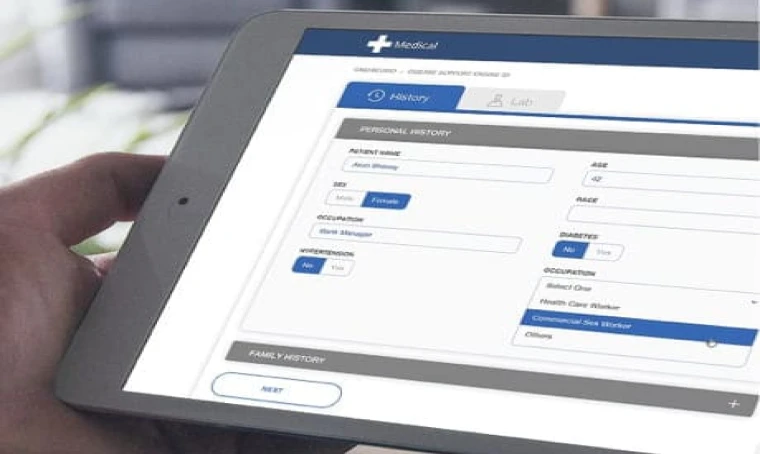People determine sales – and always will. Customer building and nurturing aren’t just about individual intuition, experience, or maintaining extensive spreadsheets. Growth-oriented organizations have evolved and use research, data analytics, & tech inputs to retain customers, tap potential leads, and foster customer relationships. We call this CRM or Customer Relationship Management – the process of using technology and data analytics to create a new customer base, retain the present, build customer relationships, and generate growth.
“I don’t know who you are, but do you want to buy a car? Or maybe a pizza? Could we also arrange the latest Loius Vuitton? We can get you anything!”
A business organization can start each day like this by posing random questions to existing/potential customers and sound like lost sheep trying to please customers at any cost.
Or, it could simply adopt CRM & show the foresight that behooves ambitious businesses. CRM is the tool that gives a business the competitive edge it needs to be the industry’s superstar.
What is a CRM system?
Brand Empathy is the driving force for B2B or B2C sales & marketing. How often have you been awed by a brand’s ability to predict your preferences, align your purchase accordingly and be responsive to your queries & needs in the post-purchase period?
Did you know – the invisible thread that makes all this possible and efficient is CRM? Customer Relationship Management or CRM is a complete system, an assortment of approaches, processes, and strategies organized in a software program, desktop or cloud-based, that a company follows to build & enhance its customer relationships and retain its customer base. By providing an improved user experience, a business gives a push to customer loyalty – the net result is that your customer stays with you.
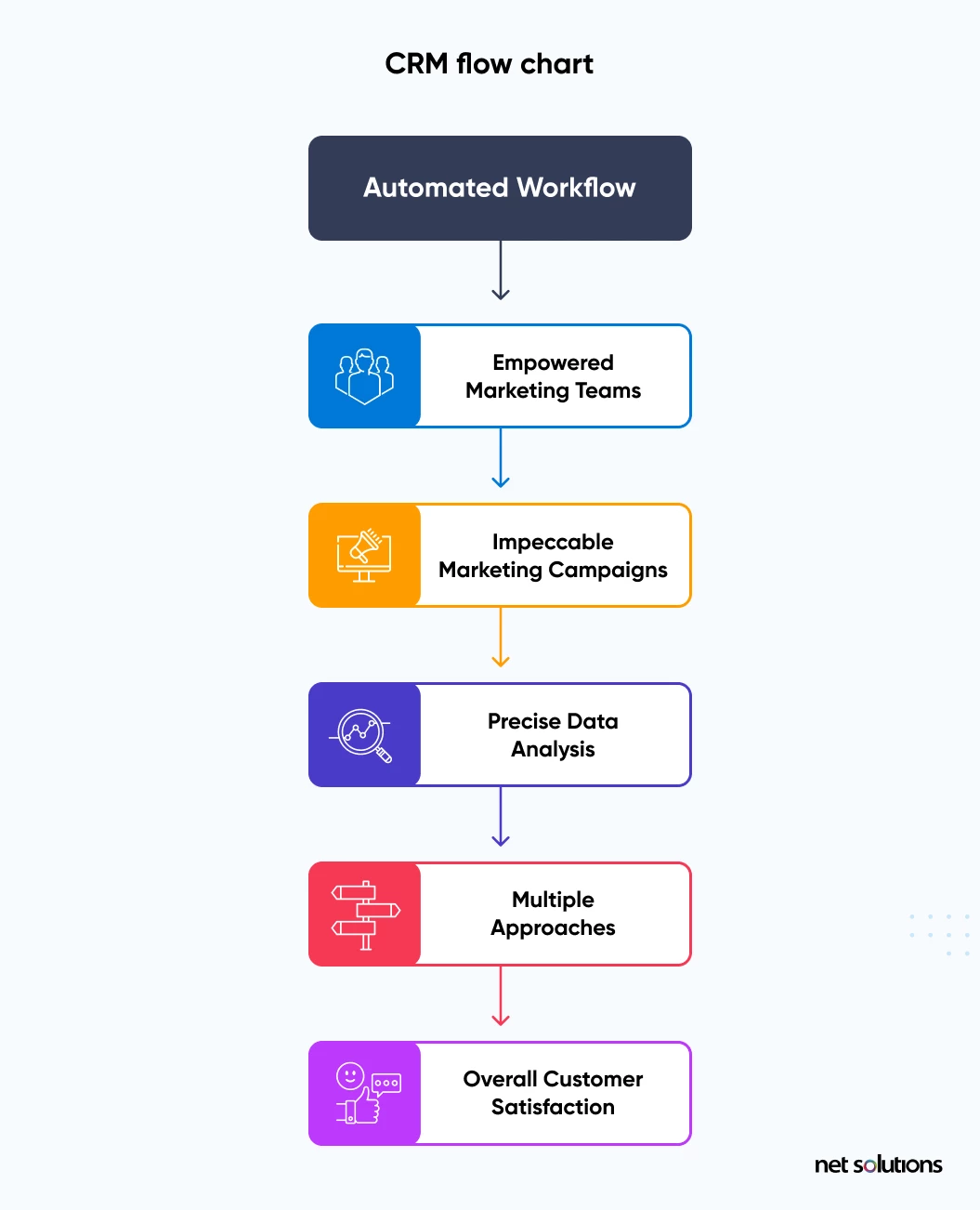
When there is a systematic flow of data collection, linkages, and analyses, users can utilize that data to understand what is happening at every ‘touchpoint’ from the customer end. This results in a precise, clear “customer profile” – and the beginning of a long-lasting business-customer relationship.
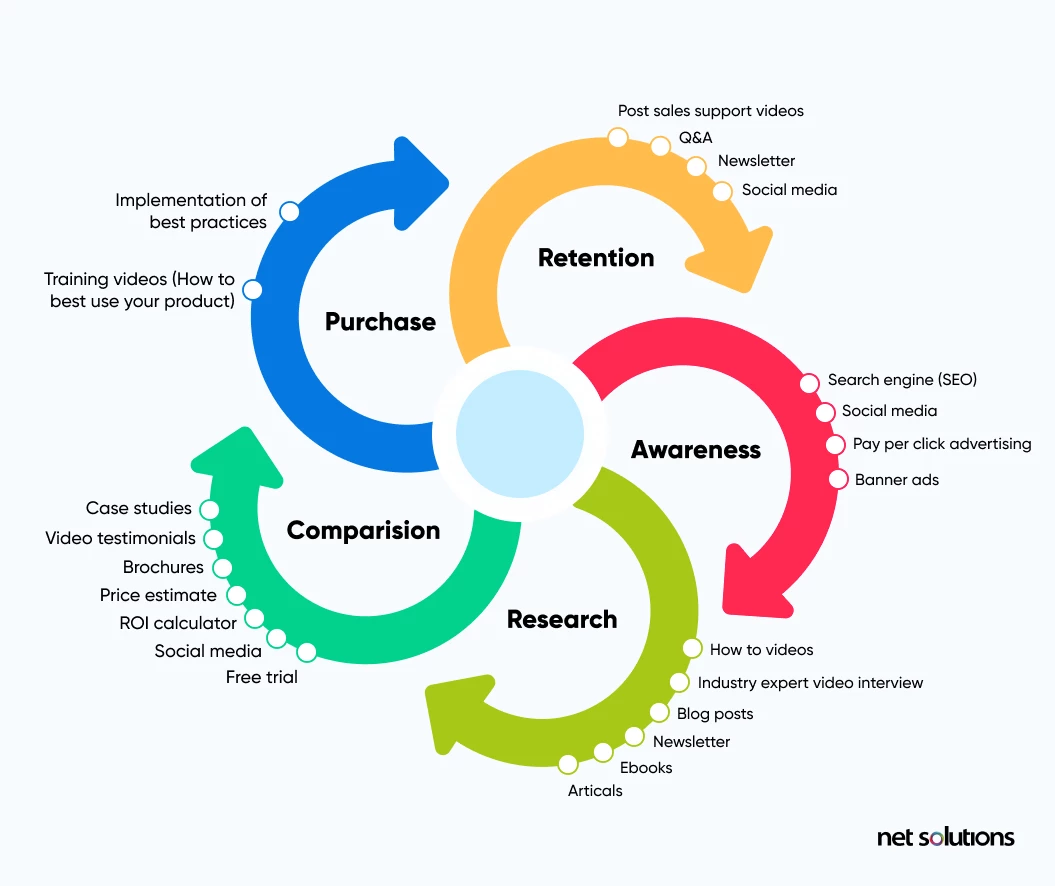
CRM isn’t a one-point magic wand; it is a sensible, well-thought
assimilation of cloud solutions that make a complete system. And rightly so! To address the customer
requirements at every touchpoint, a CRM development company provides you with a series of tools that work together to enhance
sales & productivity, support marketing, and build customer relationships.
Given how comprehensive CRM is, it loops together cloud solutions for sales, e-commerce, marketing, database accumulation & other external sources for a constant customer evaluation.
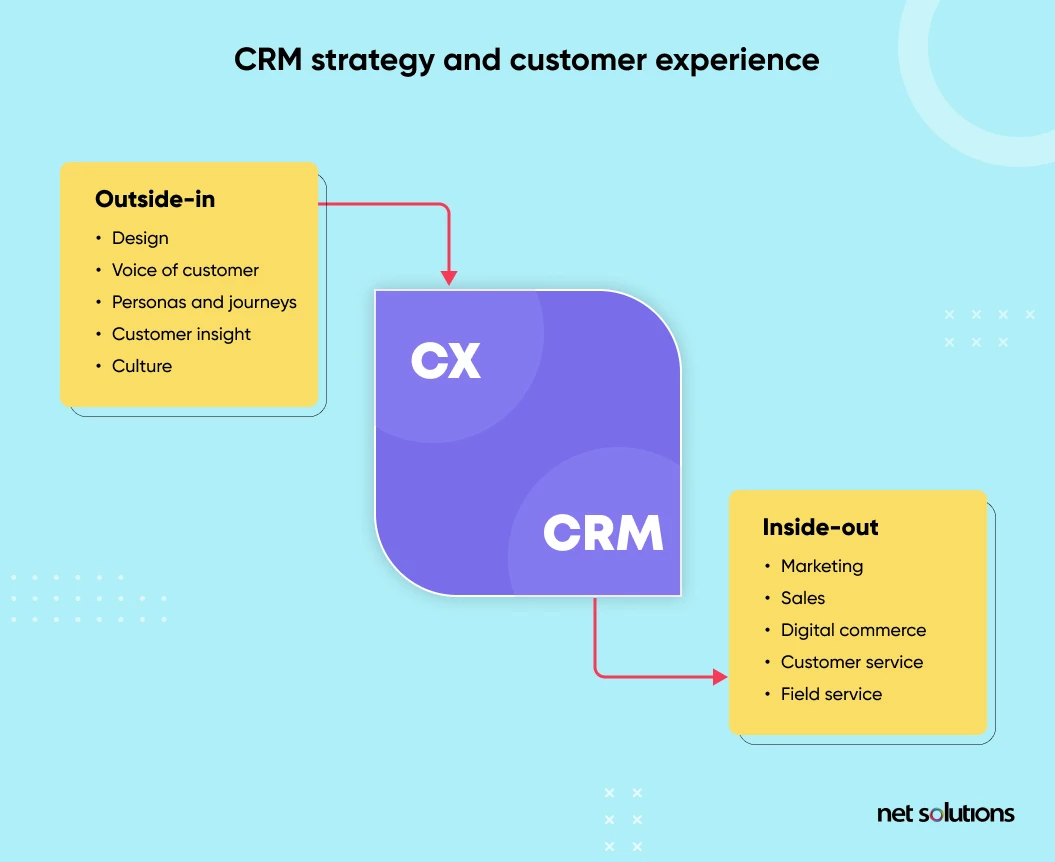
Have you ever wondered how CRM evolved? Take a look at this timeline:
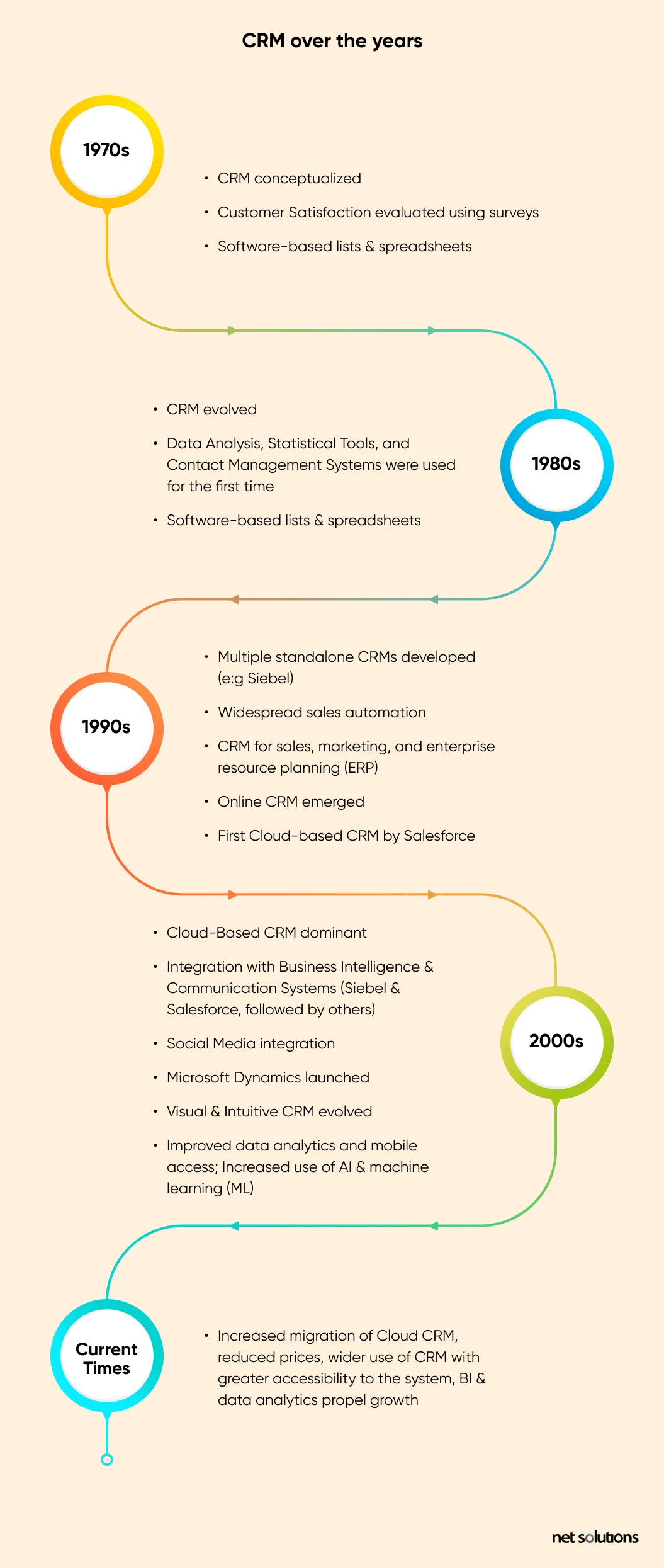
Types of CRM & choosing the right one
Research firm Gartner has aptly quoted that unless businesses make a well-planned blueprint for their CRM implementation, they will be part of the 50% failed implementations of CRM systems. The number of businesses relying on CRM systems for expansion & customer retention has been on the increase over the past few years.
To make the correct blueprint for the CRM implementation, one needs to know what types of Customer Relationship Management systems one can choose from.
Customer Relationship Management systems have both a philosophical intent and a functional aspect. The former denotes the company’s strategy, culture, processes, workforce, and vision. The latter involves actual initiatives a company would take to build its customer relationship: research, data management & analytics, direct marketing, customer base reports, and communications.
Combining these two gives a holistic picture of the customer profiles, which further pushes better relationships & business. The needs of companies would vary from industry to industry and within the same industry depending on their product base & geographical locations. Broadly, a company can decide to operate one of the following Customer Relationship Management systems:
Collaborative CRM
As the name suggests, this is about bringing together customer data for all relevant teams to view & utilize. Customer communication, purchase history, service requests, and other details are within access for all teams.
So say, a support team gets some information then shared with the marketing team, enabling them to target the suitable customer profiles. When shared with the technical team, the same information gets them to address all issues faced by customers. The service department would know too when to approach a customer for various services needed and expedite the same.
While doing this, the various teams together would handle the entire situation at the interaction and analysis levels. A track record of what was communicated to a customer and how it was communicated (email, phone, social media, etc.) helps build a base for analysis to decide which medium will be used for which customer.
In other words, we are amalgamating contact management with channel management to collaborate on the final aim – selling. Whether you use automated marketing & sales, ERP, or CPQ, you are working towards a collaborative approach to ensure you catch the customer on whichever channel they are using.
Suppose that an organization wants to provide the best & most appropriate customer experience as a business. In that case, it will need to be on as many – and all- channels that existing & potential customers can use. Along with collaborating within the organization for your CRM system, it is vital to consider the distributors, wholesalers, retailers, and other agencies that partner with you in business expansion. The data you would get regarding leads for you to close deals and deliver results.
When to choose the Collaborative CRM:
- When your departments (sales, marketing, service) are spread across different locations
- When a more significant percentage of your client interactions are online
- When different divisions of the organization interact independently with prospects & customers throughout the sales cycle.
Caution: If you have a business where you wouldn’t want customer data to penetrate the organizational divisions, this Customer Relationship Management system is not for you.
Operational CRM
This is about simplifying all processes to make it easier for the human task force to what they are best suited for, as per theory capabilities. Implying thereby that we omit the need for making humans do repetitive tasks like machines. Instead, we automate systems and delegate to machinery the functional tasks related to CRM – identifying potential customers, tracking customer interaction, forecasting sales, analyzing marketing campaigns, formulating new strategies, and creating a responsive ecosystem.
The above leads to a less complicated process flow in an organization. All systems are streamlined through three simple steps of automation:
- In the Marketing – to weave together the gamut of marketing processes within the entire web of multi-channel digital marketing. Website monitoring, email marketing, live chats with customers, and management of leads come within the scope of managing the campaigns undertaken. The idea is to find the optimal solution for product offerings & tapping the potential customer base.
- In Sales – for addressing the time consumed by all manual processes and tasks and getting them more efficiently organized. This inculcates standards within the system for dealing with both existing and potential customers. A company can enhance service quality by setting its lead & contact management, sales forecasts, call management, and problem-solving parameters.
- For Customer Service – automate the customer service platter, whether call center management, call routing, managing all information, providing self-service options, and other knowledge bases.
When to choose the Operational CRM:
- When you have linear sale procedures
- When there are a lot of repetitive tasks on a large scale
Any Business of any size & structure can benefit from this type!
Analytical CRM
With data analysis as the focus here, analytical CRM helps the top brass – management, sales, and other support staff – chalk out various ways of better customer service. Data from multiple sources is gathered for meaningful analysis of customers to gain better overviews and perspectives about how an organization functions.
The rippling effect is better decision making, better campaign management & effectiveness, improved sales & support, and an overall stronger customer relationship.
The perceptive analysis brings forward even the most subtle customer behavior patterns, thus helping a business base its future policies in the form of converting leads & forecast sales.
When an organization draws the linkages between customer behavior and intent, it becomes easier to provide personalized customer experiences. Therefore, whatever the placement of the customer in the entire buying cycle, the organization would be ready to meet their expectations.
When to choose the Analytical CRM:
- If you are a business that values data induced decision making
- If you are a service provider or an account-based sales organization that would benefit from the lead generation
Caution: This choice could be more costly and perhaps a bit more complicated than the above two types
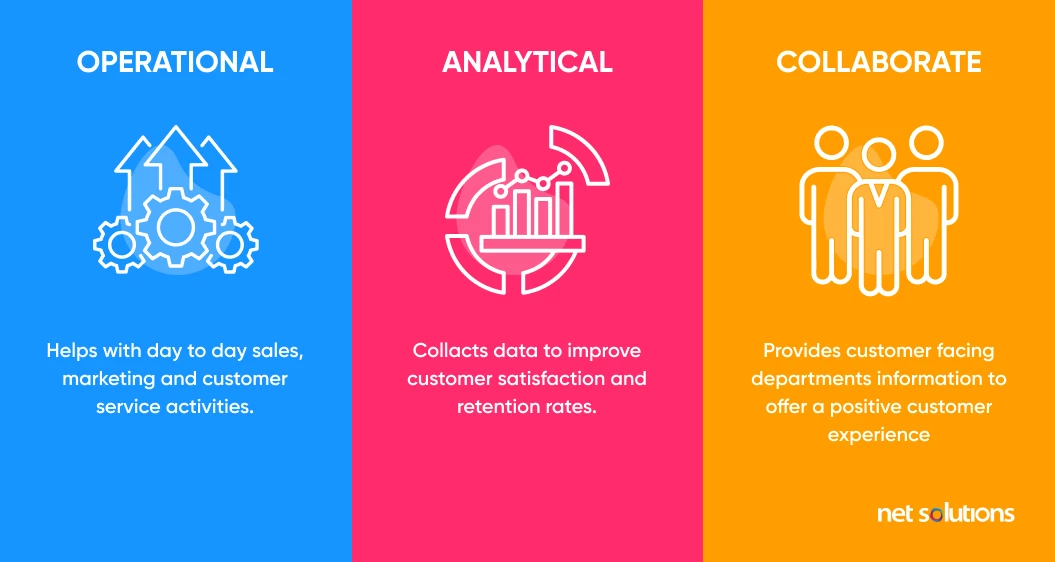
Which CRM type works in the real world?
In practice, most businesses depend on more than one type of CRM. For example, the analytical Customer Relationship Management process could provide insights integrated into operations CRM. The result would be well-targeted communication to customers based on their conditions.
Eventually, an organization will list its objectives, focus, goals, budget, and long-term strategy and then finalize its choice of CRM. A better approach would be to make a careful choice based on all this and adopt solutions that do not make you pay for features you are not using. A balanced mix of CRM strategies will work for most companies. A more prudent approach would be to take care of B2B and B2C ecosystems. No futuristic & ambitious organization can afford to neglect AI, machine learning abilities, and the database created. One needs to imbibe outsourced or mobile staff to handle this wide range of requirements.
Suppose an organization works to enhance sales, improve profits, upgrade customer relations, and retain a solid customer base. In that case, it needs to ask itself – is the CRM chosen the kind that will grow with the company? Then the choice is right!
For starters, there could be just an efficient interaction, leading to better tracking of potential customers. Over time, as the customer base grows, there would have to be a system to automate both sales & service. The next step will be to analyze data, build accurate profiles, avoid duplication and keep correcting the previous records.
While it may look tough, the reality is that systems need to be coordinated and synchronized between the marketing, sales, and service departments. This can happen when the database and go-to points are the same; there is active sharing of insights, leads, concerns, and purchase/interaction history. The net result is escalating productivity & efficiency, eliminating data gaps, and the path to working in an organization functional on efficient data management & insightful analysis. The customer stays on priority both in strategy & execution.
When does an organization need CRM?
Customer Relationship Management processes are problem-solving software systems. Are the sales figures showing a downward slide? Is there a considerable decline in the customer base? Does the growth graph reflect stagnancy? Time for the apt CRM to enter the show!
Specifically, an organization will know it needs CRM when:
- It is a struggle to maintain the business being generated, and potential, lucrative opportunities need to be tapped
- Data seems scattered, and it is tough to build customer profiles – details are incomplete, valuable profiles get lost, and follow-ups are shaky
- Customer service quality doesn’t ensure customer retention
- There is a lack of coordination between different departments – and a subsequent discord between aspirations & plans
- It seems complicated to build automated flawless reports, thus resulting in a lack of real-time, uncomplicated forecasting – time is being wasted on elaborate administrative tasks rather than the actual role of increasing sales
Over the years, several organizations have realized the value and importance of CRM and chosen to adopt the systems into their processes. Some organizations already working on an on-premise data management system have opted to switch over to efficient CRMs. This implies ‘picking up’ all data from existing systems and placing it over in the new one without losing data integrity or security. Such a shift is called CRM data migration.
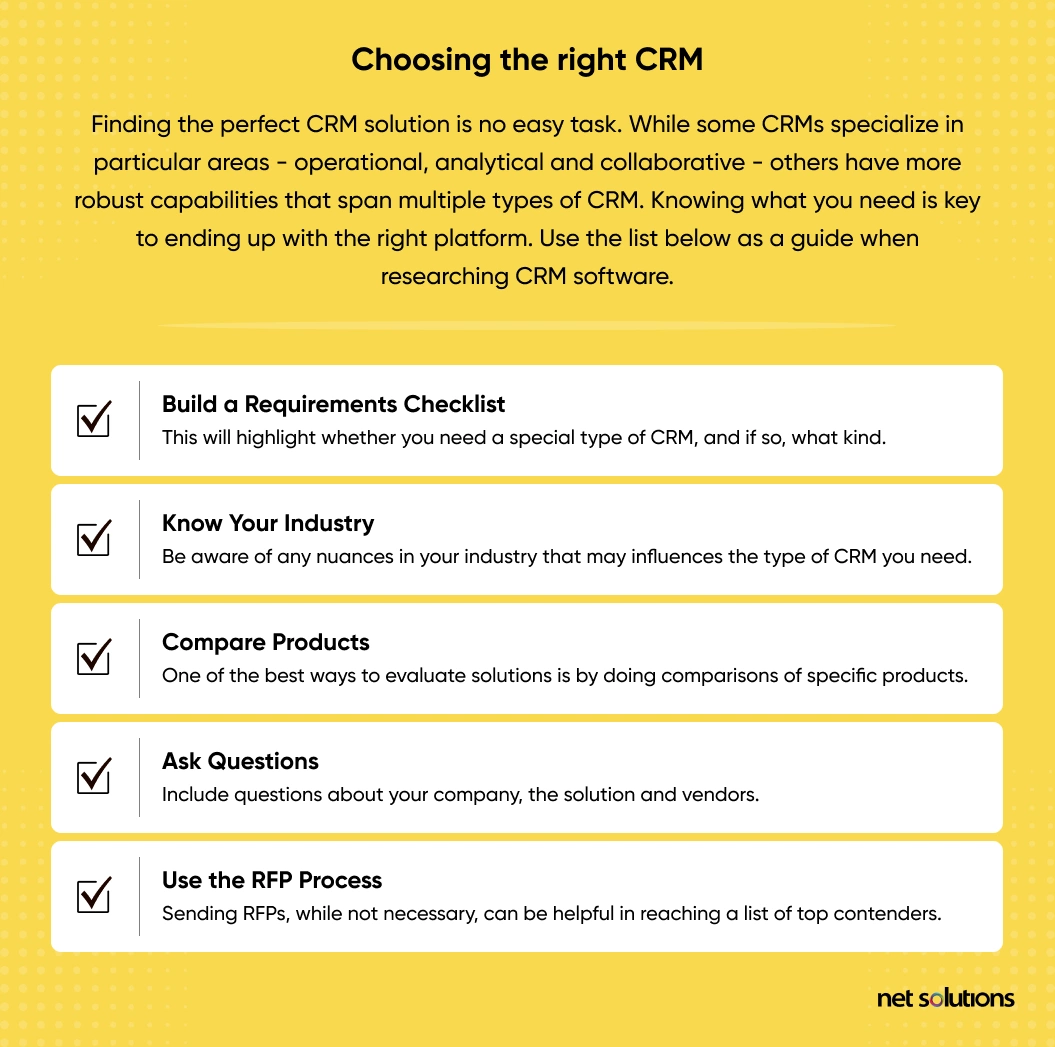
What does CRM do for your business?
Customer Relationship Management systems have brought about fundamental changes in the way businesses strategize and create structures. Earlier, managing performance was about checking documented records and analyzing them. With time, it became about digital empowerment – having the information, the data on the valuable & high-priority opportunities, the strategic planning on how to capitalize on specific leads, and the subsequent translation into the sales channel.
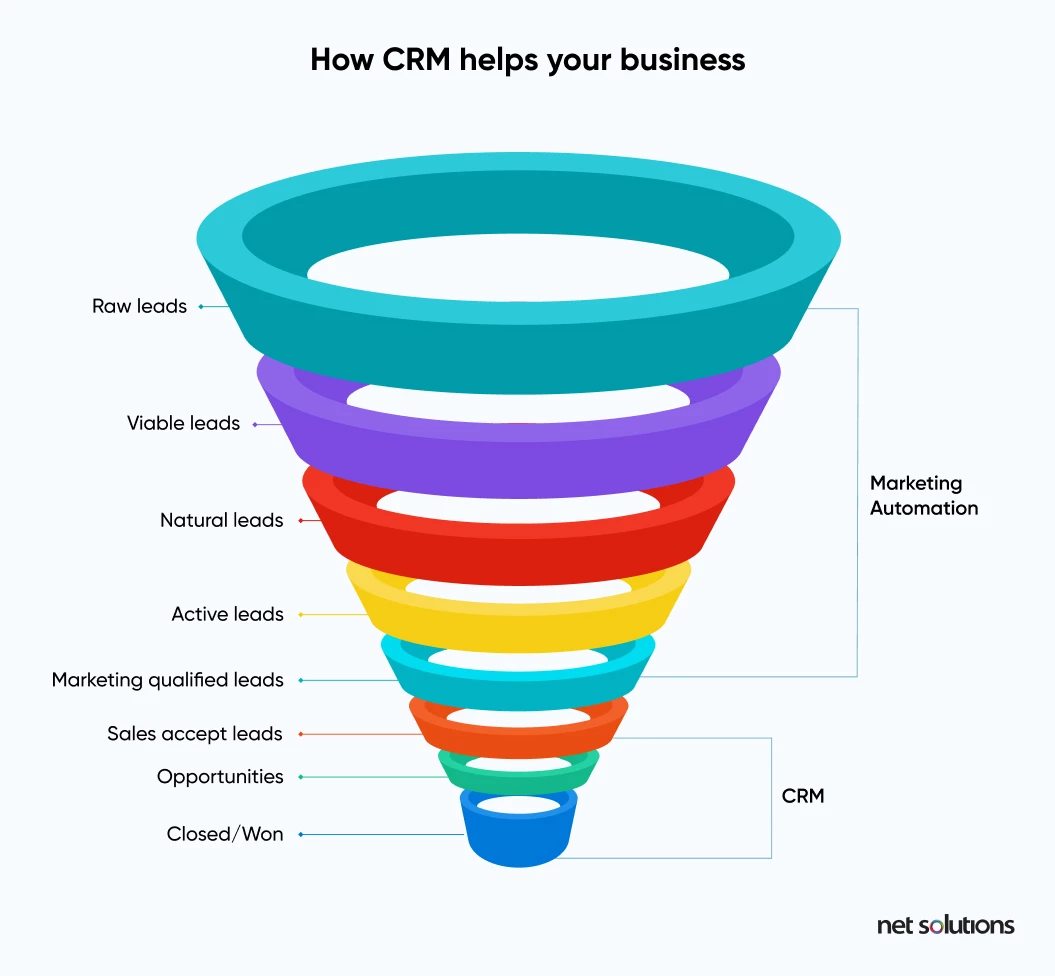
CRM:
- Answers all questions about customer data
- Organizes, manages, and interprets the available data to give a clear road map of the customer life cycle, including the vital impact points – leads are listed out more clearly
- Uses AI and analytical models to push the customer to the next step, personalize all campaigns and also encourage referrals from the existing customer base
- Uses multiple channels to optimize customer experience and thus boost sales & ROI
- Automates the strategizing process of the sales, marketing, and services teams – and then, cross-functional teams drive the transformation of the business
- Creates transparency into performances – so adjustment, realignment of goals, and targeted training become possible, and the performance culture is more action-oriented
- Pushes the organization towards the top in commercial performance by setting potential targets more dynamically
In particular, as CRM turned to Cloud, there has been:
- A surge in cost-effective working through lesser hardware or storage costs
- Greater ease of scaling
- Enhanced collaboration, coordination & insightful futuristic planning
- The convenience of working from anywhere and having access to all data anytime, anywhere
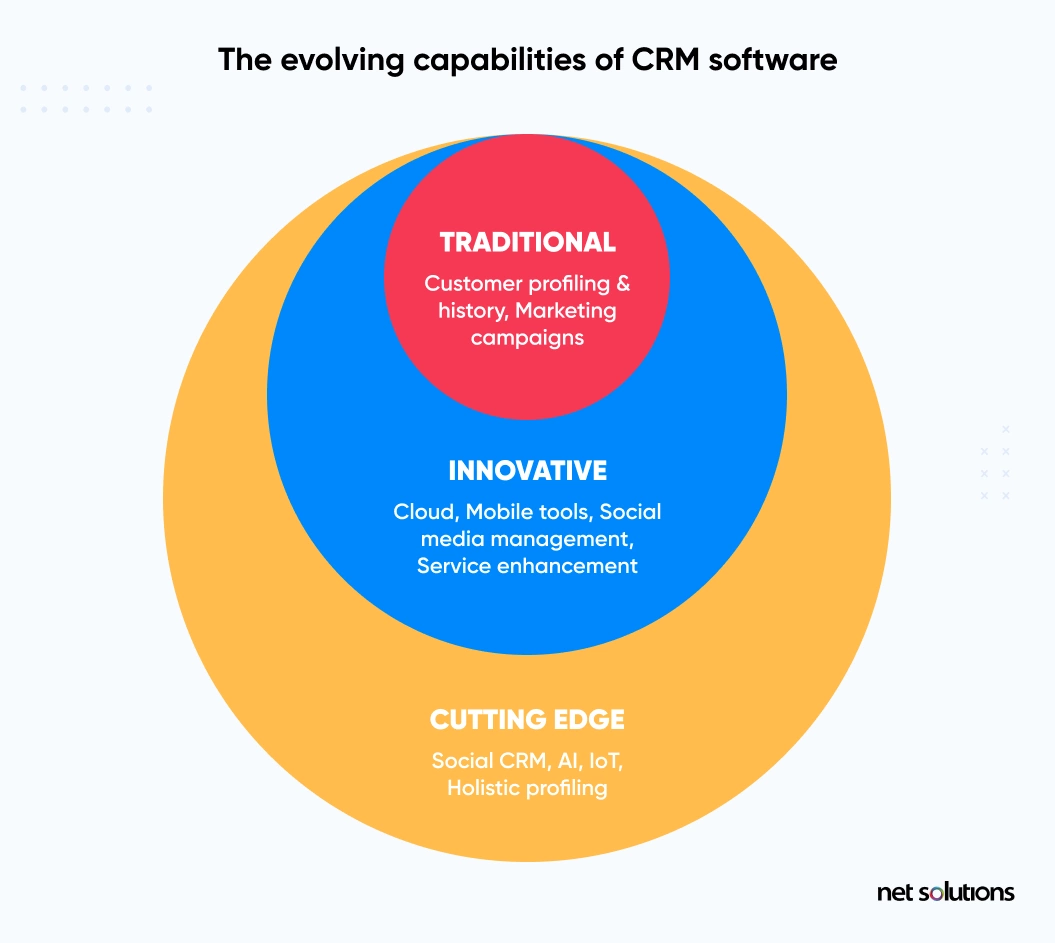
What happens when you don’t adopt CRM?
It drains your money! The more projects you handle within your organization, the more poor budget planning will hurt. Inappropriate project budget planning leads to development cost discrepancies, increased gaps in marketing, and bottlenecks in implementing product development expertise.
It could also get you considerably down in the customer expectation graph – particularly since customers today want advanced digital experiences & interfaces and higher levels of product development.
Not following CRM can lead to:
- Higher administrative costs of the manual effort to collect & store data
- Loss of vital information & details that could propel growth
- Unplanned follow-ups with customers & future strategy building
- Delayed response time and thus dissatisfied customers
- Tough extraction of data to create meaningful team coordination reports
Challenges in adopting CRM
CRM adoption could, at times, pose challenges in the process of adoption of practical systems. Adoption challenges include:
- Employee resistance to change
- Data security
- The transition from old software and procedures
- The CRM-budget balance
- Underutilization of the new systems because of a lack of knowledge
More specifically, this is what can happen while adopting CRM techniques:
1. Ambiguity on the user profile – CRM implementation often occurs only at the Sales level, and other teams/departments get neglected. Unless these systems are properly integrated, the staff will not utilize them to the fullest potential. Before purchasing a CRM, it’s important to designate what objectives you want to achieve and which team members will benefit from it the most.
2. Difficulty in usage – Since managers and leaders are core decision-makers, most CRM platforms are structured to suit their needs, and typically, features related to reporting, pipeline visibility, and forecasting are more emphasized. Features are not as intuitive as they can be, and often the people who depend on the platform for routine work skip using it. Data entry can sometimes stake longer, and people tend to avoid software usage.
3. Conflict of ‘People or Relationships’ – Are we monitoring people through a CRM system? Or the relationships? If customers are analyzed the same way as transactions, we will falter on the analysis. And if the complicated relationships have to be assessed accurately, then more innovative CRM systems must be at work. Automated data entries might be a solution – Intelligent CRM platforms supported by relationship intelligence eliminate manual contact data entry by automatically capturing data and interactions from email, calendar events, call logging, and contact information.
4. The dominance of a few companies – A few names dominate the Industry or CRM systems. Many companies often opt for a CRM industry leader before realizing it isn’t suitable for their needs. It’s never easy challenging the status quo, especially when market dominance prevails. Businesses new to the adoption system might be fearful of moving away from more prominent names like Salesforce, Hubspot, or Oracle.
While a trial period exists, it is not always possible for any business’s customer information to start reflecting anything substantial without the adding up & lines involved in full adoption. User-oriented platforms that give weightage to training processes, more straightforward deployment, and tests to see the data & relationship analysis will make it work more efficiently. Training needs to be industry-specific for better CRM adoption, transitions have to be smooth, and everyone should be using only the new CRM systems beyond a certain point.
5. Lack of support & flexibility – In practical usage, CRM systems sometimes lack the help support systems and the flexibility that a mobile sales team requires. Any customer relationship management system should ideally be mobile-friendly and offer adequate support for blockers in usage. Flexibility helps businesses gain momentum, get leads properly, improve customer relationships, and market their companies well.
What can an organization do to overcome challenges?
For a customer relationship management system to work efficiently, an organization must focus on purpose-built CRM platforms, easy-to-use solutions, customized training, & adequate support, and intelligent metric analysis regarding user behavior, goals, and user feedback. These hurdles can be easily overcome with foresight, planning insight, and adopting systems that fit the industry-specific needs.
What are the benefits of Customer Relationship Management?
CRM makes the entire work sphere of an organization more oriented toward data-driven commercial-performance management. Three things happen:
- Analytics helps develop a dynamic sales target
- Data gets organized into systematic dashboards for assessment
- The work culture becomes more action-oriented
Organizations that have adopted data-driven growth can identify substantial growth opportunities from across the customer life cycle and plan more specific target-based campaigns. They follow an omnichannel path where customer data gets aligned more precisely across all channels to attain maximum sales & conversion. Insights are more relevant; the capacity building is more robust and rigorously monitors progress across channels. The system improves holistically.
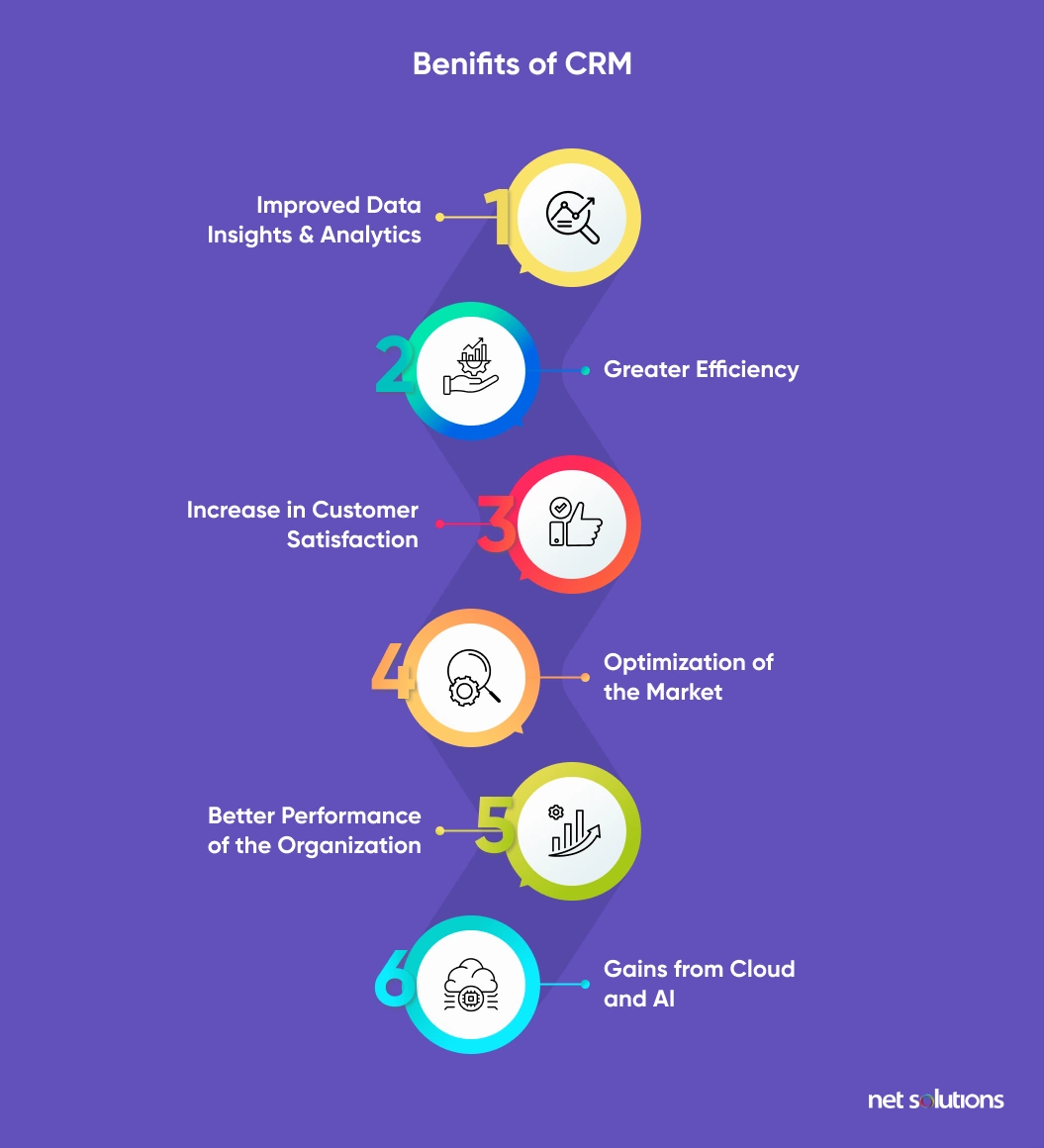
Specific benefits of CRM are:
- Improved data insight, analytics CRM provides data from every touchpoint of the customers, and behavior trends are easier to see. Data analytics consulting helps gain insights, and an organization can analyze the effectiveness of marketing campaigns more efficiently. It is also easier to address areas of particular concern.
- Greater efficiency When data becomes centralized, all teams get an overall view of the customer behavior and expectations. Conversion rates are faster. Chances of collaboration and coordination improve. All teams use the same data to formulate a strategy. Potential Issues of concern get noticed.
- Increase in customer satisfaction Proper implementation of CRM improves the Customer’s satisfaction with an organization. Since all teams are on the same page about customer preferences, behavior, expectations, and issues, the sales, marketing, and service teams’ efforts are well coordinated. Team coordination leads to better customer service solutions.
- Optimization of the market Since data is collected, analyzed, and shared at every stage, the market analysis is more focused, and all opportunities are capitalized best. Campaigns are assessed with real-time inputs, and future policies get framed better. CRM systems trace purchases & feedback, analyze what influences purchases, and decide on which marketing channels to target in the future.
- Better performance of the organization (increased revenue, decreased costs) Every organization knows that there are two ways to grow – increase your revenue or decrease your expenditure. CRM helps to attain both! Revenues see an augmented chart because of better potential tapping & leads. Expenses see declines because of a reduction in storage costs, to begin with. Further, manual efforts get minimized, and avoidable administrative costs are reduced. CRM also makes it possible for an organization to scale faster.
- Gains from cloud and AI With the world now in an anytime anywhere access network, it becomes convenient for all teams to access all kinds of data. Salespeople can focus on their conversion efforts more, marketing strategize better, and service teams can proactively handle issues.
What is the future of CRM?
The Customer is King – and always will be. All CRM systems will naturally focus on a customer-centric approach while representing a voice for customers and businesses. The overall strategy will be aligned and adopt AI & ML as a norm in all practices.
Further, IoT will improve customer experience. We see increased prominence of Mobile for sales engagement happening and personalized solutions growing. With this, the social network will also support the backbone.
The functionality, scope, and impact of CRM systems would take shape as per these future trends:
- Synchronization between sales & marketing If CRM has to operate at the capacity & speed that customers want, there will have to be a complete alignment of the goals, targets, and spheres of the marketing, sales, and services departments. Digital transformation strategies will have to rethink to streamline processes & business models around seamless customer experience. Marketing will have to work to get the leads, and sales will then have to pick them up to follow up using the same CRM systems, and the two departments need to drop internal conflicts and operate on unified actions.
- AI & IoT as the two pillars of CRM A prominent number of industries have their foundations in SaaS. More and & more CRM systems are incorporating AI into their applicability. Whether conversation-based intelligence programs or other analytics, AI is everywhere in all software. Even in Marketing processes, AI is increasingly used to create data-driven models and channels. IoT has come to penetrate more in cybersecurity, smart home systems, and other such gadgets. Data that gets generated through these systems help improve customer experience. AI also brings greater self-service into the system (example-chatbots for a quicker response). Automated communication leads to more significant contact interaction, better customer lead management, valuable engagement, and thus optimal use of resources.
- Mobile CRM on the rise Remote working is rising, and there is an increasing demand for CRM solutions compatible with mobile UIs. This is going to be an investment worth the effort for any organization. In the tech stacks used for CRM, the Mobile UI has to be a priority – for data to be in the zone of ‘anytime, anywhere, anyhow.’ Leads can be seen anytime, and you need to tap them. Opportunities could be on any medium, and you’d have to make sure you notice – and if you can access these on your phone, you’d always get in touch. Net gain – Increase in productivity.
- Alignment of social CRMs with social media If customer data has to be better organized and relationship management enhanced, CRMs need to work on all social channels. A customer needs to feel he “owns” a conversation, and the organization needs to open doors to new kinds of discussions. Lead generation, brand awareness, and organizational loyalty stand to gain if Social CRM can tap the customer. Quicker responses to the customers keep them more satisfied with the overall experience with a company.
- Personalization & voice UI Human relationships are at the core of AI and CRM systems. Therefore, organizations need to align their CRM more and more to voices and conversations in the coming times. Every experience needs to be personalized, and voice technology will become a more aggressive input in CRM. And personalization at every step is meant to satisfy all customers and retain both B2B & B2C bases. The system must integrate support tickets, chatbots, online meetings, event participation, and content downloads.
- Broader market base While this shift has already happened during post-pandemic times, CRM will crawl into health, insurance, manufacturing, finance, hospitality, etc.
How to choose the best CRM
How do you choose one that works for you in the wide range of Customer Relationship Management systems available?
A good CRM software should help you with every aspect of your business. You can decide on the most appropriate system for your company based on the efficacy of the following criteria:
Managing leads & contacts – The heart of all sales & marketing is ‘people.’ A CRM system, therefore, should be able to guide you on how to manage them (predict behavior, tap prospects and organize that data). The process starts from searching for prospects to the conversion point, and there must be efficient collecting, storing, and managing of contact information. If there is integration with social media and other contact apps, it maximizes a fruitful prospect search.
Managing deals – The ‘deal management feature’ is meant to increase productivity, set milestones, assign tasks, create deadlines, and have an entire workflow process for the sales & marketing team. Good campaign management for maximum effectiveness is vital.
Automation – An automated system sets the efficiency high and weaves together tasks assigned for sales & marketing. Workflows are smoothened, and processes & workflows become more evident. Further, if it can integrate & connect various departments in an organization, customer profiles get created more completely. Automation & Integration supports sound communication systems too, which are vital to proficient CRM. Third-party integrations set the pace for better campaign management too.
Reports & Analysis – Your CRM system should be able to give you reports about sales forecasts, market analysis, customer insights, future revenue reports, etc. Post these reports; the CRM has to be able to come up with a sound analysis. Learning from the data helps manage the entire system better.
Customization – The CRM system has to cater to your specific needs and how your business processes work, and your CRM application should work as your business works. The terms, requirements, workflow, and the App integration that your CRM accommodates must be per your specific needs.
Ease of use – For any CRM to be practical and functional, it is helpful if the operability is easy to understand. Although the ease of usage is a relative factor, and not everything can be a cakewalk, accessible support systems, helplines, help articles, and guides lead to a more productive experience.
How should someone decide which cloud computing platform to choose? Here is a breakdown of the different cloud computing platforms (AWS vs Azure vs Google Cloud):
Top 11 most popular CRM systems in use
Based on all the above, here’s our take on some of the top Customer Relationship Management systems, in brief, and their comparative analysis:
Hubspot
For: Startups, Agencies, Small Businesses, Large Enterprises
Features: Email, Social Media campaigns, Lead management, Explore Traffic, Conversion Analytics, Customer support, Workflow & Pipeline management, Marketing Automation, Document & Campaign Management
Highlights: Customization, Excellent Marketing Automation, Smooth UX, Easy to Use, Innovative
Salesforce
For: Small Businesses, Startups, Enterprises, Fast-growing Businesses
Features: Lead management, Analytics, Forecasts; Opportunity, Contract & Performance Management, Customer support, On-Demand (SaaS), Cloud Computing
Highlights: Automation, Customization, Innovation & regular updating, Ease of App usage
Zoho
For: Startups, Agencies, Enterprises, Freelancers
Features: Sales & Marketing Automation, Business Intelligence, Inventory Management, Social Media Integration, Voice & Data Integration, Funnel Analysis, Heat Maps
Highlights: Affordable Excellent for scaling a Business, Customization, 360 degrees customer view, Comprehensive Reporting Section, Customizable CTAs, Gamification, Convenient One-License Subscription
Oracle
For: Startups, Small, Medium & Large Enterprises, Freelancers
Features: Sales & Marketing Automation, Inventory management, Social CRM, Mobile App, Customer Support, Project & Solution Management, Territory Management, Customer Data Platform, Fusion Marketing
Highlights: Content Management, AI, Cloud Infrastructure, Low-code development, Smooth UX, Analytics & Identity Management, High Security, Business Intelligence, Audience Segmentation
Microsoft Dynamics
For: Startups, Enterprises, Agencies, Small to Midsize Businesses
Features: Market & Sales Automation, Email Integration, Marketing Collaterals, Supplier-Purchase-Solution Management, opportunity Management
Highlights: Social Insight, Business Intelligence, High productivity, Flexible & Cost-effective, High Customization, Intuitive UI, Powerful BUilt-in tools, Flexible Architecture
Freshworks
For: Small Businesses, High Growth Businesses, Agencies, Freelancers, Startups, Medium Enterprises
Features: Bulk emails, Advanced Reporting & Customization, Territory & Lead management, Auto profile enrichment, Mobile Apps, Multiple Pipeline tracking, Real-time Analytics, Dynamic Mapping, Multi-Language & Currency
Highlights: Simple & Easy to use, Good UI & UX, User engagement tracking, Flexible Sales Process, Smooth Integrations, Visual Editors, Easy customization & personalization
Pipedrive
For: Small to Midsize Businesses, Freelancers, Startups
Features: Excellent Lead Management, Application Integration, Pipeline Management, Online Activation, Lead Capture, Segmentation & Management, Email Integration
Highlights: Simple usage, Reasonable, Excellent Visuals
Sugar
For: Freelancers, Startups, Small Businesses
Features: Marketing Automation along with Collaterals, Customer Support, Onsite Implementation, Partner Cloud, Solution & Opportunity Management, Mobile App
Highlights: High customization, Broad range of Integrations, User friendly, Reduced operating costs, Powerful Workflow tools
Bitrix 24
For: Startups, Small, Mid Size Businesses
Features: Marketing Automation and Collaterals, Customer Support, Onsite Implementation, Partner Cloud, Solution & Opportunity Management, Mobile App, Interaction Tracking, Cloud Computing
Highlights: Wide language support, Highly Customizable, Exclusive Calendar systems, Efficient organizational task format, Fine time management systems, Multi-channel operationality
NetHunt
For: Small & Midsize Businesses, especially those who depend on Gmail & other Google Workspaces, Agencies, Freelancers, Startups
Features: Mass email, Easy installation with Google workspace, data export & import, Mailing list management, Campaign Segmentation, Calendar Sync, Action item tracking, Audience targeting
Highlights: Customizable, Converts emails into records, Extracts customer information even before mail is opened, Viewer tracking, Native mobiles Apps
LeadSquared – CRM
For: Startups, Small & Large Enterprises
Features: Marketing Automation & Sales execution, Drip Marketing, Audience segmentation, Customer support & management, 360 degrees customer view, Demographic data, Mobile App
Highlights: Lead tracking, Lead Qualification & Distribution, BehavioraL Insight, Reducing lead leakage, detailed Sales & Marketing analysis
The latest trends to check out in your CRM system
While opting for CRM, keep in mind these future trends will set one CRM system apart from others:
- Business Intelligence (BI) – for better data analysis and smarter decisions; new trends like customer persona, buying behavior, and market influences, thus facilitating multi-channel marketing campaigns.
- Cloud CRM – is not only affordable, has flexible solutions, is low maintenance, offers good integration & real-time analytics, and has greater efficiency.
- Multiple integration options – Modern CRMs that can provide you with a more significant number of integration options make your business workflows smooth. Multi-channel options aimed at refined compatibility & responsiveness add to the value of the CRM systems.
- Refined analytics – CRMs that offer predictive behavior analytics offer businesses new insights on both sales & marketing strategies.
- Self-service – These reduce team workloads. Gartner reports say almost 75% of the businesses would prefer self-service channels.
- Responsive content strategy – The in-depth analysis from CRM will be increasingly used to define Content strategy especially landing pages, emails, and blogs, creating a higher number of leads & sales. Social Media, content marketing, and mobile being integrated enhance productivity.
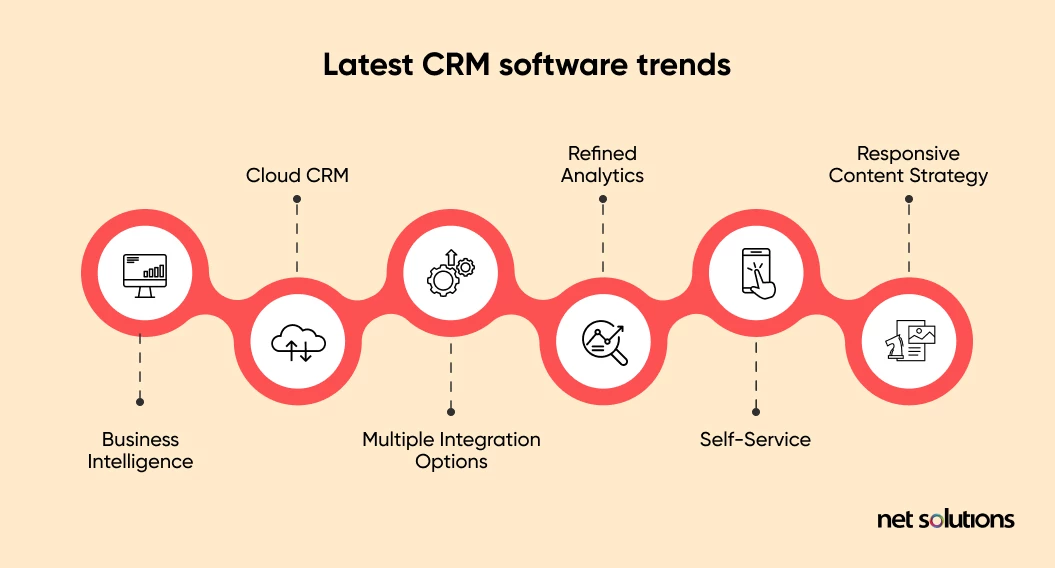
What works for you is also suitable for you at the end of the day. Choosing a CRM system is no exception to this rule of life.
Bottom Line? A CRM must have agility and scope for continuous improvement. It should be able to keep data updated. Besides investing in complementary assets, it should integrate with other enterprise information systems.
The underlying base behind all CRM is marketing psychology – the art of understanding how customers feel, think, and make decisions. It gives an organization an edge over its competition. And your choice of CRM will become your tool to walk towards that competitive edge in a more systematic & planned manner.

